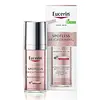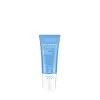What's inside
What's inside
 Key Ingredients
Key Ingredients

 Benefits
Benefits

 Concerns
Concerns

 Ingredients Side-by-side
Ingredients Side-by-side

Water
Skin ConditioningAlcohol Denat.
AntimicrobialButylene Glycol
HumectantGlycerin
HumectantOctocrylene
UV AbsorberIsopropyl Palmitate
EmollientCetearyl Isononanoate
EmollientDistarch Phosphate
AbsorbentMethylpropanediol
SolventIsobutylamido Thiazolyl Resorcinol
BleachingSodium Ascorbyl Phosphate
AntioxidantSodium Hyaluronate
HumectantGlycyrrhiza Inflata Root Extract
Skin ConditioningTocopherol
AntioxidantGlucosylrutin
AntioxidantSodium Stearoyl Glutamate
CleansingGlyceryl Stearate
EmollientSodium Polyacrylate
AbsorbentDimethicone
EmollientIsoquercitrin
AntioxidantCitric Acid
BufferingSodium Chloride
MaskingTrisodium EDTA
Caprylyl Glycol
EmollientPhenoxyethanol
PreservativeParfum
MaskingWater, Alcohol Denat., Butylene Glycol, Glycerin, Octocrylene, Isopropyl Palmitate, Cetearyl Isononanoate, Distarch Phosphate, Methylpropanediol, Isobutylamido Thiazolyl Resorcinol, Sodium Ascorbyl Phosphate, Sodium Hyaluronate, Glycyrrhiza Inflata Root Extract, Tocopherol, Glucosylrutin, Sodium Stearoyl Glutamate, Glyceryl Stearate, Sodium Polyacrylate, Dimethicone, Isoquercitrin, Citric Acid, Sodium Chloride, Trisodium EDTA, Caprylyl Glycol, Phenoxyethanol, Parfum
Water
Skin ConditioningGlycerin
HumectantPropylene Glycol
HumectantHydrogenated Polydecene
EmollientDicaprylyl Carbonate
EmollientPolyglyceryl-6 Distearate
EmulsifyingZea Mays Kernel Extract
Cetearyl Alcohol
Emollient1,2-Hexanediol
Skin ConditioningCetyl Ethylhexanoate
EmollientJojoba Esters
EmollientPolyglyceryl-3 Beeswax
EmulsifyingCetyl Alcohol
EmollientAcrylates/C10-30 Alkyl Acrylate Crosspolymer
Emulsion StabilisingCeramide NP
Skin ConditioningDipropylene Glycol
HumectantSaccharide Isomerate
HumectantEthylhexylglycerin
Skin ConditioningBHT
AntioxidantPotassium Hydroxide
BufferingButylene Glycol
HumectantAcacia Senegal Gum
MaskingDisodium EDTA
Tocopheryl Acetate
AntioxidantSolanum Lycopersicum Seed Oil
EmollientXanthan Gum
EmulsifyingHydrogenated Lecithin
EmulsifyingCaprylic/Capric Triglyceride
MaskingButyrospermum Parkii Butter
Skin ConditioningVaccinium Macrocarpon Seed Oil
Skin ConditioningGlyceryl Stearate
EmollientDipotassium Glycyrrhizate
HumectantSodium Hyaluronate
HumectantHelianthus Annuus Seed Oil
EmollientPPG-6-Decyltetradeceth-30
EmulsifyingCeramide Ns
Skin ConditioningCeramide As
Skin ConditioningCeramide AP
Skin ConditioningCholesterol
EmollientSodium Hyaluronate Crosspolymer-3
HumectantCitric Acid
BufferingSodium Citrate
BufferingGlycyrrhiza Glabra Root Extract
BleachingMadecassoside
AntioxidantTocopherol
AntioxidantPentylene Glycol
Skin ConditioningLycopene
AntioxidantCeramide EOP
Skin ConditioningWater, Glycerin, Propylene Glycol, Hydrogenated Polydecene, Dicaprylyl Carbonate, Polyglyceryl-6 Distearate, Zea Mays Kernel Extract, Cetearyl Alcohol, 1,2-Hexanediol, Cetyl Ethylhexanoate, Jojoba Esters, Polyglyceryl-3 Beeswax, Cetyl Alcohol, Acrylates/C10-30 Alkyl Acrylate Crosspolymer, Ceramide NP, Dipropylene Glycol, Saccharide Isomerate, Ethylhexylglycerin, BHT, Potassium Hydroxide, Butylene Glycol, Acacia Senegal Gum, Disodium EDTA, Tocopheryl Acetate, Solanum Lycopersicum Seed Oil, Xanthan Gum, Hydrogenated Lecithin, Caprylic/Capric Triglyceride, Butyrospermum Parkii Butter, Vaccinium Macrocarpon Seed Oil, Glyceryl Stearate, Dipotassium Glycyrrhizate, Sodium Hyaluronate, Helianthus Annuus Seed Oil, PPG-6-Decyltetradeceth-30, Ceramide Ns, Ceramide As, Ceramide AP, Cholesterol, Sodium Hyaluronate Crosspolymer-3, Citric Acid, Sodium Citrate, Glycyrrhiza Glabra Root Extract, Madecassoside, Tocopherol, Pentylene Glycol, Lycopene, Ceramide EOP
Ingredients Explained
These ingredients are found in both products.
Ingredients higher up in an ingredient list are typically present in a larger amount.
Butylene Glycol (or BG) is used within cosmetic products for a few different reasons:
Overall, Butylene Glycol is a safe and well-rounded ingredient that works well with other ingredients.
Though this ingredient works well with most skin types, some people with sensitive skin may experience a reaction such as allergic rashes, closed comedones, or itchiness.
Learn more about Butylene GlycolCitric Acid is an alpha hydroxy acid (AHA) naturally found in citrus fruits like oranges, lemons, and limes.
Like other AHAs, citric acid can exfoliate skin by breaking down the bonds that hold dead skin cells together. This helps reveal smoother and brighter skin underneath.
However, this exfoliating effect only happens at high concentrations (20%) which can be hard to find in cosmetic products.
Due to this, citric acid is usually included in small amounts as a pH adjuster. This helps keep products slightly more acidic and compatible with skin's natural pH.
In skincare formulas, citric acid can:
While it can provide some skin benefits, research shows lactic acid and glycolic acid are generally more effective and less irritating exfoliants.
Most citric acid used in skincare today is made by fermenting sugars (usually from molasses). This synthetic version is identical to the natural citrus form but easier to stabilize and use in formulations.
Read more about some other popular AHA's here:
Learn more about Citric AcidGlycerin is already naturally found in your skin. It helps moisturize and protect your skin.
A study from 2016 found glycerin to be more effective as a humectant than AHAs and hyaluronic acid.
As a humectant, it helps the skin stay hydrated by pulling moisture to your skin. The low molecular weight of glycerin allows it to pull moisture into the deeper layers of your skin.
Hydrated skin improves your skin barrier; Your skin barrier helps protect against irritants and bacteria.
Glycerin has also been found to have antimicrobial and antiviral properties. Due to these properties, glycerin is often used in wound and burn treatments.
In cosmetics, glycerin is usually derived from plants such as soybean or palm. However, it can also be sourced from animals, such as tallow or animal fat.
This ingredient is organic, colorless, odorless, and non-toxic.
Glycerin is the name for this ingredient in American English. British English uses Glycerol/Glycerine.
Learn more about GlycerinGlyceryl Stearate is a mix of glycerin and stearic acid.
It is used to stabilize the mixing of water and oil ingredients. By preventing these ingredients from separating, it can help elongate shelf life. It can also help thicken the product's texture.
As an emollient, it helps soften skin and supports barrier-replenishing ingredients.
In cosmetics, Glyceryl Stearate is often made from vegetable oils or synthetically produced.
This ingredient may not be fungal-acne safe
Fun fact: The human body also creates Glyceryl Stearate naturally.
Learn more about Glyceryl StearateSodium Hyaluronate is hyaluronic acid's salt form. It is commonly derived from the sodium salt of hyaluronic acid.
Like hyaluronic acid, it is great at holding water and acts as a humectant. This makes it a great skin hydrating ingredient.
Sodium Hyaluronate is naturally occurring in our bodies and is mostly found in eye fluid and joints.
These are some other common types of Hyaluronic Acid:
Learn more about Sodium HyaluronateTocopherol (also known as Vitamin E) is a common antioxidant used to help protect the skin from free-radicals and strengthen the skin barrier. It's also fat soluble - this means our skin is great at absorbing it.
Vitamin E also helps keep your natural skin lipids healthy. Your lipid skin barrier naturally consists of lipids, ceramides, and fatty acids. Vitamin E offers extra protection for your skin’s lipid barrier, keeping your skin healthy and nourished.
Another benefit is a bit of UV protection. Vitamin E helps reduce the damage caused by UVB rays. (It should not replace your sunscreen). Combining it with Vitamin C can decrease sunburned cells and hyperpigmentation after UV exposure.
You might have noticed Vitamin E + C often paired together. This is because it is great at stabilizing Vitamin C. Using the two together helps increase the effectiveness of both ingredients.
There are often claims that Vitamin E can reduce/prevent scarring, but these claims haven't been confirmed by scientific research.
Learn more about TocopherolWater. It's the most common cosmetic ingredient of all. You'll usually see it at the top of ingredient lists, meaning that it makes up the largest part of the product.
So why is it so popular? Water most often acts as a solvent - this means that it helps dissolve other ingredients into the formulation.
You'll also recognize water as that liquid we all need to stay alive. If you see this, drink a glass of water. Stay hydrated!
Learn more about Water